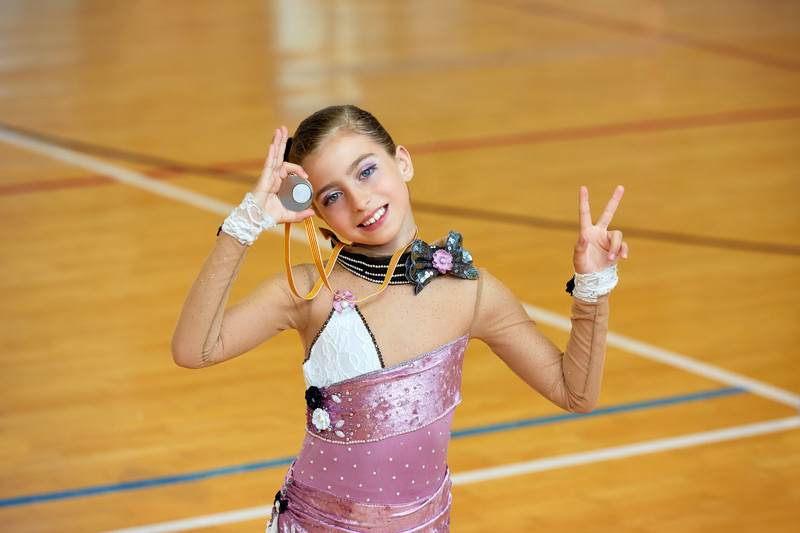When you think of gymnastics, you probably think about floor routines, uneven parallel bars, the vault, and balance beam, but there are two types of gymnastics, rhythmic gymnastics and traditional gymnastics.
Rhythmic gymnastics is different than traditional gymnastics because it is performed solely on the floor and uses equipment in floor routines. Below, you will find out everything you need to know about rhythmic gymnastics.
Rhythmic Gymnastics Requirements
Rhythmic gymnastics has evolved since its beginnings in Ancient Egypt. Today, this form of artistic expression includes leaps, tosses, jumps, and a variety of other moves on the floor. Gymnasts performing rhythmic routines use a variety of different apparatuses in their routines including balls, ropes, hopes, balls, clubs, and ribbons.
When rhythmic gymnasts are judged during competitions, judges are interested in their dance ability, grace, and their coordination.
Who Competes in Rhythmic Gymnastics?
Ever since rhythmic gymnastics was added to the Olympic programme, only female gymnasts have been eligible to compete in the sport. Most rhythmic gymnasts begin the sport when they are very young. Participants are eligible to compete in International and Olympic Games on January 1st of their 16th year.
Although most rhythmic gymnasts are females, there are some men in the sport. The most notable male rhythmic gymnasts are from Japan. Unlike traditional rhythmic gymnastics, males in this sport often add martial art skills and tumbling to their rhythmic routines.
What does it Take to be a Rhythmic Gymnast?
To be a rhythmic gymnast, an athlete must possess balance, coordination, flexibility, and strength. In addition to these physical attributes, the gymnast must also have the maturity and fortitude to compete under extreme pressure, and possess self-discipline and an extremely dedicated work ethic.
Rhythmic Gymnast Apparatus Types
There are five different rhythmic gymnast apparatuses; including rope, ball, hoop, ribbon, and clubs.
Understanding Rhythmic Gymnastics Competitions
Rhythmic gymnastics routines are fundamentally different than traditional gymnastics routines and competitions. Here we will go over the things that make rhythmic gymnastics routines unique. This information will help you understand a rhythmic gymnastics routines and the way the competition works.
All-Around (Individual)
As mentioned above, there are five apparatuses that can be used in an all-around competition. During an individual all-around competition, a gymnast will compete on four of the five events.
The reason an athlete does not compete on all four events is because one apparatus is rotated out of competitions every two years. After an athlete has performed using four of the five devices, their total score is added together.
Group Competitions
Group rhythmic gymnastics routines are different than individual routines. For instance, in competition all athletes in the group will use the same apparatus for the first routine. (They can pick any of the four currently in rotation) In the second routine, all gymnasts use two different pieces of equipment.
Judges assign a score for each routine, and then the scores are added together for a group all-around score.
Understanding Routine Scores – Execution Score vs. Final Composition Score
Each rhythmic gymnastics routine tops out at a score of 20.0. Judges use an Execution Score and a Final Composition Score to get to 20.0. The Execution Score begins at 10.0 for each gymnast. Deductions are taken for technical faults during the routine. A technical error can include catching an apparatus incorrectly or failing to catch an apparatus.
The Final Composition score uses an artistic score and a difficulty score. The artistic score maxes out at 10.0 and is based on choreography and music. The difficulty score begins at 0 and maxes out at 10.0. The difficulty score rises depending on the complexity of the athlete’s routine.
Understanding Rhythmic Gymnastics Requirements
Many spectators are often confused by scoring. The Code of Points can be difficult for anyone to understand, especially audiences, but the tips below will help you identify great routines without understanding all the finer points of the Code.
- Form and Execution – Just like traditional gymnastics, form and execution are an important part of any rhythmic gymnastics routine. When looking for form and execution, it is important to pay close attention to all jumps and leaps. A gymnast’s toes should be pointed, and the body should have an overall tightness. Each skill the athlete completes should look planned and executed correctly.
- Apparatus Control – When a gymnast is using an apparatus, the equipment should always be moving. Additionally, the gymnast should maintain control of the gear at all times. Anytime a gymnast drops the apparatus; it is a deduction. A simple drop is a deduction, and extra deductions are taken if the apparatus rolls off the floor, or away from the gymnast during the routine.
- Choreography – A great rhythmic gymnastics routine includes a lot of intricate movements. The music and moves performed during a routine should be entertaining.
- Overall Flexibility – Flexibility is an important element in rhythmic gymnastics. When completing splits, leaps, or jumps, the gymnast must achieve 180-degree splits. In fact, the bigger, the better. Flexibility should also be evident in the athlete’s legs, shoulders, and back.
- Routine Uniqueness – The more unique a rhythmic gymnastics routine is, the better. Judges want to see routines that stand out from the rest. Risky moves, difficult throws, and catches, and complicated choreography are sure to get the judge’s attention and increase scores. The gymnast should also display extreme flexibility and a uniqueness from other competitors to increase their scores.
Now that you know everything there is to know about rhythmic gymnastics, you will be a better spectator or competitor. Feel free to add comments about the concentration below.

